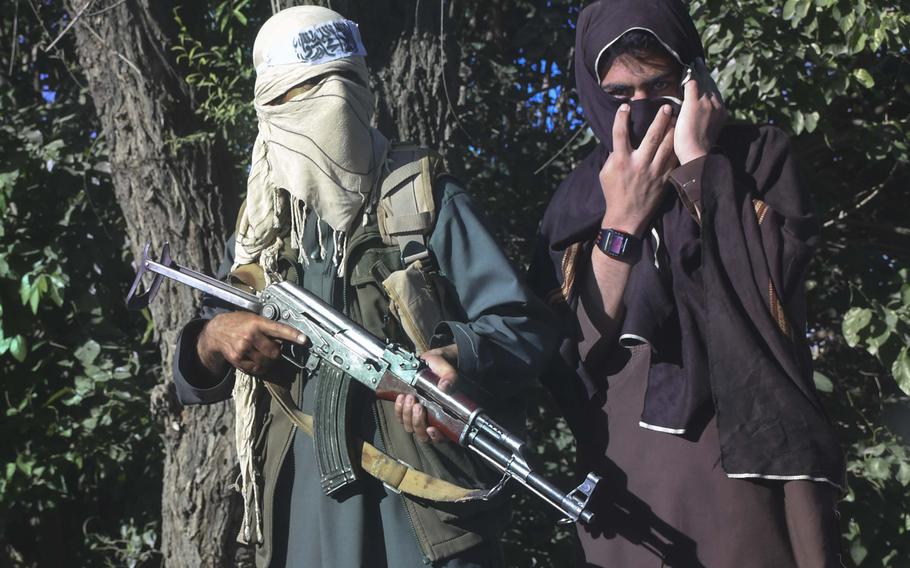
Armed alleged Taliban watch a convoy pass through in Logar province during a cease-fire between the Taliban and the Afghan government in 2018. The United States must start preparing for the reintegration of Taliban fighters into Afghan society, or risk losing some of them to terrorist groups like the Islamic State, the Special Inspector General for Afghanistan Reconstruction said in a report Wednesday. (J.P. Lawrence/Stars and Stripes )
KABUL, Afghanistan —Taliban fighters could join other militant groups in Afghanistan, such as the Islamic State group, if the United States does not help reintegrate them into Afghan society once a peace deal has been struck, a U.S. watchdog said this week.
“If ex-combatants are not accepted by their communities or are unable to find a new livelihood, they may be vulnerable to recruitment by criminal groups or terrorist organizations like the Islamic State,” a report by the Special Inspector for Afghanistan Reconstruction cautioned.
Recent talks between American and Taliban officials aimed at ending the U.S.’s longest war highlighted the need to incorporate an estimated 150,000 insurgents into the military, government and other areas, to make enduring peace likely, said the report released Thursday.
Drawing on lessons from the war, which will go into its 19th year on October 7, SIGAR called on Washington to immediately start planning for risks and challenges associated with eventual reintegration as soon as possible, the report said.
Afghan officials and some militants have warned in recent weeks that a peace deal could push Taliban hardliners to join other small, but ruthless extremist groups, either to continue anti-government attacks or as a safe haven against retribution for their insurgent activities. “Some unknown number” will remain a threat after a deal is reached, the Pentagon has also said.
The report was the first comprehensive government study of all post-2001 reintegration programs in Afghanistan.
The United States has spent roughly $65 million on such programs during the 18-year war, targeting both the Taliban and pro-government militias, the report said.
“None of these reintegration programs succeeded in enabling any significant number of ex-combatants to socially and economically rejoin civil society,” SIGAR said.
New efforts are also likely to fail unless the Taliban first reaches a peace settlement with the Afghan government, it said.
“Without a peace agreement in place, any proactive effort to reintegrate Taliban fighters may backfire, since the Taliban leadership still view reintegration as surrender,” SIGAR said.
After nearly a year of discussions, the U.S. and the Taliban were said to have reached an agreement in principle earlier this month that was expected to outline a gradual withdrawal of roughly 20,000 foreign troops from Afghanistan, of which about 14,000 are American. It was also expected to pave the way for talks between the Taliban and the Afghan government, which has been excluded from the process so far.
But just days after it was announced that a deal had been reached, President Donald Trump abruptly called off negotiations, citing a suicide car bombing in Kabul that killed an American soldier. Trump later said talks with the insurgents were “dead,” though officials from both sides have hinted they could resume at a later date.
The absence of a comprehensive political settlement or peace agreement was the “key factor” in the failure of previous programs that sought to reintegrate the Taliban, SIGAR found. Other important factors were insecurity, a weak economy and limited government capacity to implement programs.
“Many factors that contributed to the failure of previous reintegration programs persist to this day, creating an environment that is not conducive to a renewed reintegration effort while the insurgency is ongoing,” SIGAR said.
Regardless of the status of the peace negotiations, not having a plan for the eventual reintegration of Taliban fighters into Afghan society could pose a risk to the U.S.’s development efforts in Afghanistan, SIGAR warned.
U.S.-funded development programs in the country should “take into account the circumstances and needs of former combatants and their families,” and Washington should lend its support to a transitional justice process, led by the Afghans, “which will be critical to underpin successful long-term reintegration,” the report said.
SIGAR also recommended that the U.S. finally designate an office to handle reintegration matters. Even after nearly two decades of war, “the U.S. government has no lead agency or office for issues concerning the reintegration of ex-combatants,” the report said. “In Afghanistan, this has contributed to a lack of clarity about reintegration goals and their relation to reconciliation.”
wellman.phillip@stripes.com Twitter: @pwwellman